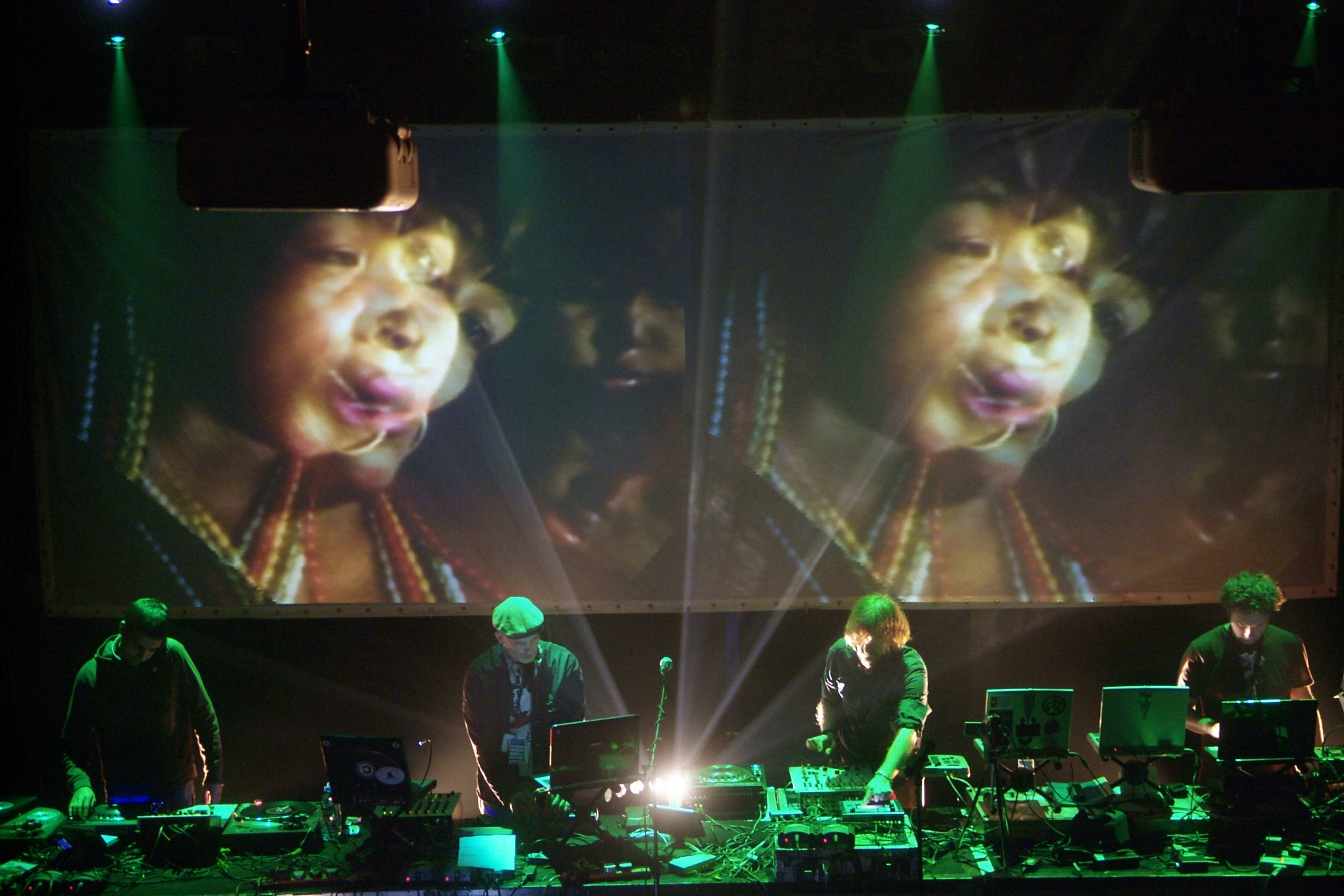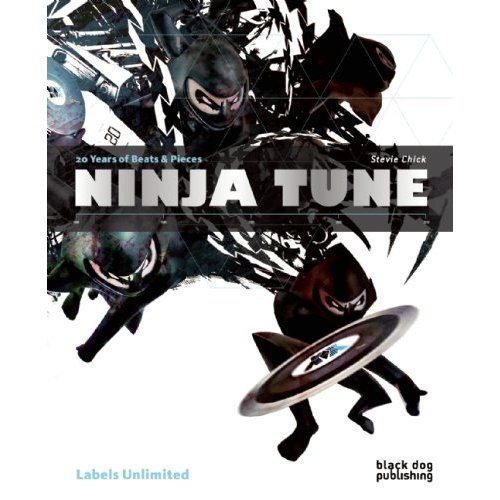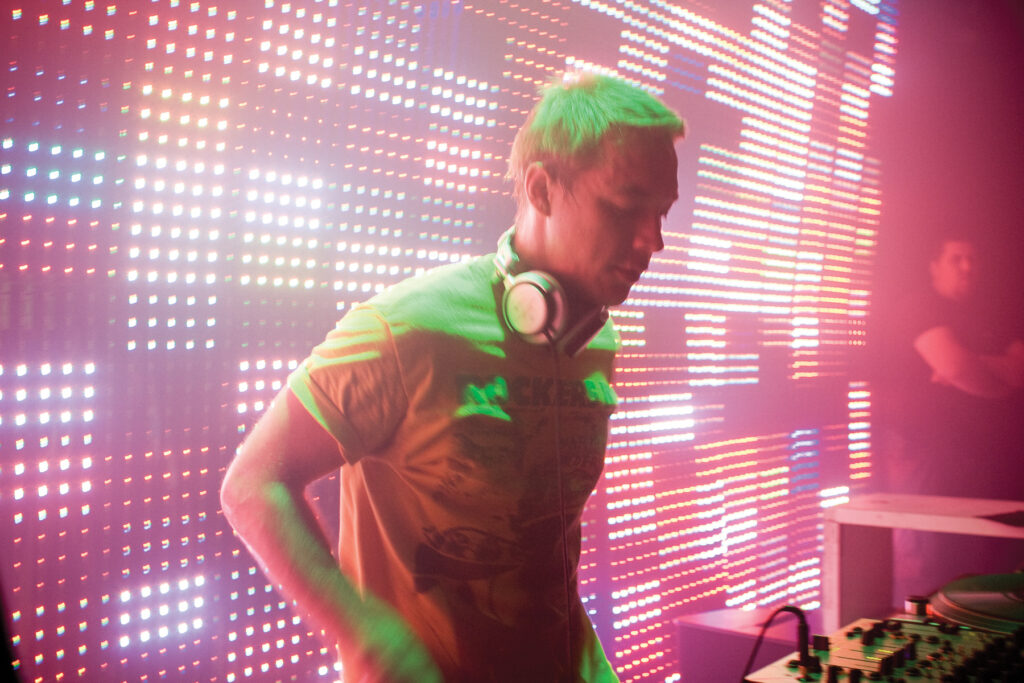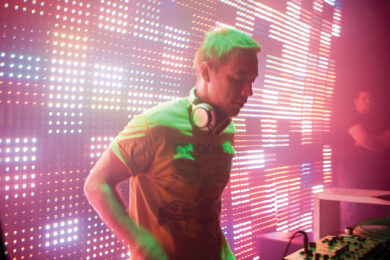As the Nineties dawned, London’s Shoreditch wasn’t the hive of culture it became after the dotcom boom, but rather a wasteland of warehouses and neglect. As the decade reached its midway point, however, Shoreditch sputtered into life, this cold husk slowly awakening into a thriving hub of creative activity, a rebirth that began, in no small part, thanks to the Blue Note. A three-storey nightclub in Hoxton Square, the Blue Note was run by Sav Remzi, founder of the Nuphonic record label, who’d enjoyed success with his jazz club, the Red Eye; tapping the services of a handful of hip London record labels, the Blue Note soon won a reputation for pioneering, successful and unique
club nights.
"I used to live round the corner from the Blue Note, back when Old Street was still half-empty," remembers future Ninja-employee and Ninja artist Jason Swinscoe. "The Blue Note had the hippest record labels running DJ sessions there, with lots of experimentation: James Lavelle running his Mo’ Wax club there, Talvin Singh’s Anokha nights, Phil Asher’s Disco loops. Every Sunday night, around 7pm until midnight, cups on my shelves would rattle from the sub-bass coming from Goldie’s Metalheadz night."
Ninja Tune began hosting their own night, Stealth, at the Blue Note in December of 1995, following a successful launch party for DJ Food’s Recipe For Disaster album at the venue. "It’s rare to find a club owner willing to let you experiment," remembers Coldcut’s Jonathan More, of Stealth. "Every great club night has been a combination of an open-minded club-owner, a wayward promoter, and a bunch of crazy people who want to do shit that nobody else is doing."
"The very first night, there were queues around the block," remembers Shane Solanki, who promoted the first nights. "We thought, ‘what’s happening?’ So many people market their club nights to fuck, but we were having fun, dicking around and enjoying ourselves, and our first night was a sellout!"
It was the era of opulent Super-Clubs like Cream, Turnmills and
Ministry Of Sound but, says Suzi Green (who soon took over the running of Stealth, after Shane went travelling), "The Blue Note wasn’t like those clubs. People weren’t dressing up to go to Stealth: it was dark and dingy, and the floor was sticky and dirty. But if the lights were out and there were pretty projections running, you didn’t realise it was a shit-hole!"
The club’s three floors allowed Ninja to host a variety of moods and environments across the different rooms. "We’d have the Light Surgeons or Matt running visuals upstairs for the ‘Chill-Out’ room," remembers Suzi, "The middle floor had DJs, and the basement was a sweaty room with a stage that could just about hold five musicians, or four turntables for Ninja’s trademark mix sessions. You’d struggle to get a drink, because people were dancing right up to the bar, to this mad mixture of music. One night a guy in the crowd just jumped onstage and played theremin along to the DJ!"
Named Club Of The Year by NME in 1996, Stealth was a perfect showcase for Ninja artists to perform and DJ, to get their music heard, and the label’s identity permeated everything from the ground-breaking visuals, to the collectible flyers designed by Strictly Kev. They welcomed DJ sets and performances from artists outside the stable, too. "Kruder & Dorfmeister played their first UK set at Stealth," remembers Shane, "and Squarepusher played bass music in the basement – that was amazing. Bjork came down. And I had to turn Arthur Baker away one night, because it was just too rammed inside. He was all, ‘Don’t you know who I am?’, and I said, I’m sorry, that’s really not how we do business. Maybe if he’d been Afrika Bambataa…"
The queues that snaked around The Blue Note for every Stealth night, were drawn in by the vibe, the visuals, but most of all by the barrier-demolishing musical policy. "It was the beginning of
eclecticism coming back into the main room," says Strictly Kev.
"Before Stealth, the main room was just Techno or House, 4-on-the-floor stuff. We took the ethos of our Solid Steel show off
the radio-waves and into the main room, playing everything from
Drum’n’Bass, to Hip-Hop, to Funk, to Electronica, to Techno…"
"I’d never heard slow, heavy music like that in a club before, with the whole room going nuts to it," remembers Simon Green, who would later record for Ninja Tune as Bonobo, of the night DJ Krush guested alongside DJ Food at the decks. "It was heavy and deep, rather than fast and loud, and that really made an impact. It was the most musically forward-thinking night out I’d ever had."
Overindulgence of potent hash cookies given to him by the promoter of a show he played the night before may help explain sweet-toothed DJ Vadim’s particularly vivid memories of that night. "I was on the dancefloor when the cookie kicked in, and was so absolutely stoned I couldn’t move, but I was having these amazing visions… Matt and Jon and Krush were DJing together, and the lights were coming up from behind them, and it just looked like some holy moment. The club was entirely packed and rocking, and I was sweating so much… Best night of my life…"
"[Ninja Tune label compilation] Funkjazztical Tricknology came out shortly before Stealth started up, which was great timing," says Kev. "We had a hot compilation, a night at a very hot venue, and that just focused everyone, in 1996, on Ninja Tune, and all the things that went on within it. That was the beginning of the first Golden era of Ninja, really."
The success of the Stealth nights inspired the label to send their show on the road, as Suzi booked nights across the country – and then later across Europe and the rest of the world – featuring DJ sets from Ninja luminaries, and live performances from groups like Up, Bustle & Out and The Herbaliser, who had evolved into ‘proper’ bands featuring live musicians alongside the turntables and sequencers.
The package tours’ ground-breaking bills of live artists and DJs
would introduce countless new audiences to the proudly polymorphous Ninja brand, but there were sometimes struggles. "Venues couldn’t get around a night that featured live bands and DJs," says Suzi, who quickly assumed the role of in-house Tour Manager. "They wouldn’t have the right set-up for a live band, or it was a night-club and they were expecting DJs, so the punters didn’t really show up until 1am."
"We did a show with Coldcut in Italy in 1994," adds Kev, "and we
played for about twenty minutes, and then all this whistling started. We thought they were loving it, but it became a cacophony of wolf-whistles, and that’s apparently how they diss you in Italy. What we were doing was just too new for them. In 1995, we played annual music-industry showcase Popkomm in Germany, with three DJs manning four decks onstage, basically scratch-jamming over all sorts of stuff… People were scratching their heads, saying ‘we’ve never seen or heard anything like this before in our lives’. And they got it, slowly."
"Amon Tobin used to pretty much clear dancefloors on his first tour, because he was so ‘out there’," says Ninja press agent Vez, of one label signing who underwent an intense ‘trial by fire’ before audiences could catch up to what he was doing.
"The audiences did hate me, with a passion," remembers Amon. "People were booing and trying to get me off the stage, and I had several projectiles thrown at me. But I felt, very strongly, that it was irrelevant to me whether someone wanted to hear it or not. I was going to do it anyway."
"He was so fucking uncompromising, he just kept on doing it," adds Jeff Waye, head of Ninja’s North American branch, admiringly. "A year or two later, he was headlining 2000 person capacity venues, a massively-successful artist in his own right."
Mostly, though, veterans of Ninja’s excursions harbour fond memories of their time on the road, playing their music in far-flung corners across the globe, and on grand stages closer to home. "I played a club in St Petersburg" remembers Funki Porcini’s James Braddell, "and suddenly there was this really bizarre smell, and it was hard to breathe. Someone had let off tear gas in the club, which is apparently quite common in Russia, as a joke: it’s their equivalent of a stink bomb. Some people left the club, but the rest took out handkerchiefs and just kept on dancing. I thought, if they’re fucking staying, I’m
staying too!"
Touring with Ninja was nothing like legendarily scabrous Led Zeppelin biography Hammer Of The Gods: forget coke and groupies, Ninja artists struggled instead with their debilitating addictions to vinyl. "They were all really competitive," remembers Suzi. "They’d all be up at dawn, trying to get to the second-hand record shops first. If there was a spare bunk in the bus, it would be full up with vinyl. That’s what it was all about for them: trainers, graffiti, records."

Simon Green saw Kev and DJ partner DK take this competitiveness to ridiculous levels while touring North America. "We were in Vancouver, playing a show later that night on Vancouver Island. The ferry was going to take two hours to get us across, but DK ended up hiring a helicopter and choppering across in ten minutes, just so he could get to the record shop before Kev! We bought so many records on that trip that we had to have crates of them shipped home separately, and the night after they arrived back in London, we had a tour reunion on the Solid Steel radio show, playing a mix composed entirely of records we’d bought on tour."
"I wouldn’t say any of the tours were particularly raucous," laughs Kev. "Certain people got their groupie action, but I’m not going to mention any names. Suzi’s going to write a book one day, and actually name names. That’s what she’s threatening, anyway…"
Eighteen months after it had begun, Ninja Tune drew the regular
Stealth nights to a close. "Someone asked Jon why we were closing the club when it was still packed out every month, and he said, ‘All good things must come to a trend’," says Suzi. "The crowd was changing, and getting a bit more yobby, and it had lost its soul a bit."
The next regular Ninja club night, Funkungfusion – named after the then-current Ninja label compilation – would take place nearby, upstairs at the 333 on Old Street, a venue even gnarlier than the Blue Note. "Not long before we arrived, it had been a really seedy club," laughs Suzi. "One night early on, somebody called the Fire Brigade and said we’d overfilled the club, and when they arrived the club-owners said we had to ‘lose’ fifty to a hundred people. So I had to shift all these people through this little door to the upstairs, yelling ‘Free beer! But only if you move fast!’ They sat in the offices with a few crates of free beer until it was safe to come down."
Stealth and Funkungfusion were only the first of an ongoing series of regular club nights and live events Ninja have run, including the You Don’t Know nights at the Big Chill House and Electrowerkz. The Xen Solid Steel nights at Cargo continued the ground-breaking blend of live acts and DJs in a venue that finally offered enough space for the live acts to spread their wings as well as Ninja club nights as far afield as Brussels, Paris, Tokyo and Osaka, and big tent shows at the Big Chill and Secret Garden festivals, along with 2004’s international
touring A/V extravaganza, Zen TV. A regular Solid Steel night later moved on to the West End’s Ruby Lo, morphing into a DJ night with a door charge of £3, with the line-ups kept secret until the night. Notable appearances include Four Tet, Rob Da Bank, Diplo’s first ever UK DJ set, a pre-King Cannibal Zilla, The Scratch Perverts and, of course, a host of Ninjas.
"Ruby Lo was a cheesy West End bar, but it suited us," remembers DK. "We wanted people to drop in after work, to sit and listen to the music, or to take to the dancefloor if they felt like it. It was like the radio show, in a club format, and it ran for two years. We had some brilliant guest DJs: Kentaro, Steinski, Coldcut… Luke Vibert came down one night, with Aphex Twin in tow, and they were more people with their cameras out taking pictures of Aphex than there were dancers, which kind of spoilt it, really. After two years, I moved out of London, and Kev and his wife had twins, so we wound the club down, but we went out with a bang: we performed our first Solid Steel mix-CD live, and gave away every record that we played." They didn’t give up
on the format entirely though and had already set up a Bristol branch in conjunction with Detectives Of Perspective which ran for 5 years and played host to equally impressive line ups on a bi-monthly basis.
Though Suzi no longer works for the label – she now arranges events for kindred spirits The Big Chill – she remains a Ninja in every way that counts, and holds their DIY ethos in high regard. "It’s funny how the music industry has changed," she smiles. "For financial reasons, touring has been stripped way back, with fewer and fewer road crews, the way we used to do it. A lot of bands don’t realise it’s their money they’re spending if they get someone to carry all their kit… the fools! But with Ninja, we did it all ourselves. We never thought of doing it any other way."
The Quietus also grabbed Stevie Chick for a brief Q & A about his new tome
When did you first become aware of Ninja Tune and why did its aesthetic and output appeal to you so much?
Stevie Chick: I first became aware of Ninja back in its first flush of mainstream success, the ‘Trip Hop’ era if you will. I’d just started to immerse myself in hip-hop, and all the possibilities offered by turntables and sequencers and samplers, and Mo Wax’s Headz compilation opened a door in my mind to the more abstract, instrumental stuff that was happening then. Mo Wax seemed to get more immediate press buzz back then, but it didn’t take me long to start exploring artists like Funki Porcini and Coldcut, and their first big compilation, Funkjazztical Tricknology, suggested there was much to get lost in with regard to their catalogue. But you know, I was at university, trying to balance a means-impoverished budget with a desire to hear as much music as I could, from as many different genres, and I could just about afford to buy an album a week back then. The week before I bought Funkjazztical Tricknology, I might’ve bought an Uncle Tupelo album, and the week after an Alkoholiks LP – Spotify didn’t exist back then, and even illegal file-sharing was beyond the capabilities of my 56k modem, so I couldn’t really immerse myself in stuff on my budget in those days. But I do remember having a pretty natty Ninja T-Shirt, a mauve ringer tee (as was the fashion in those days) with Strictly Kev’s Ninja and a
slogan about getting blunted but not getting too much fluff on your needle (fnarr).
A couple of years later, however, and I was writing about music for a living, and every single Ninja release I wanted to hear was tumbling through my letterbox, for free, along with a lot of other music from an infinite number of other labels. And I was struck by the uniformity of quality of Ninja Tune’s output, and that, by the late 90s, that was the only kind of uniformity the label countenanced: that here was a label which was, by definition of how many of its artists made their music, ‘hip-hop’, but never constrained by genre: taking this
revolutionary method and spinning it out as far as the imagination and the technology would allow. Ninja Tune releases could mangle your brain and send you hurtling towards the dancefloor, like Coldcut’s More Beats & Pieces; they could also hit you on an emotional level with a delicate force that left you moved and breathless, like The Cinematic Orchestra’s ‘All That You Give’. That breadth of sound and style and content would only expand in the years that passed and – along with their ethical approach to business and the uncommon decency of the people involved at the label, who I came to meet while writing about their releases – only increased my admiration for Ninja Tune’s works.
Did you go to Stealth or listen to Solid Steel on KISS FM? How was Ninja a part of your life apart from just buying records?
SC: I was a Solid Steel listener, no doubt, though I never made it down to Stealth, I don’t think – again, during Stealth’s lifespan, I was mostly broke and studying or spending my nights at the Garage or the LA2 or similar dives. Dumb as it sounds, I figured I’d rather spend my ‘entertainment dollar’ on live music than turntablism, a methodology I would later curse once I started attending club nights and catching DJs at work. Certainly, researching the Stealth chapter for the book
made me green with envy, at the great times I missed. As such, I was unprepared for how mind-blowing Ninja artists’ multimedia performances would be in the flesh – I have a very clear memory of Hexstatic and Coldcut and DJ Food at 93 Feet East, for Ninja’s 10th birthday celebrations, dancing to the chainsaw roars of ‘Timber’ and watching the very source of those sounds – video clips of tree felling and ecological destruction – spool out upon massive screens before me. It was disorientating, it was overwhelming, it was fucking awesome.
What is it about Ninja Tune that differentiates it from the other trip hop/blunted beats style labels such as Mo Wax?
SC: Honestly, the simplest and most obvious answer to that is, they’re still going, still thriving. Unpack that pat answer, and you’ll find the real reasons: the label balance a creative adventurousness with a keen and sensible business approach, and have never been satisfied with standing still or being synonymous with a single sound or movement, and have retained a hunger that’s served them, and their fanbase, incredibly well. The early Mo Wax releases were great, and the Ninja bods give them heavy props throughout. But a couple of years after Headz, Mo Wax was less an outlet for great music, and more the label run by that bloke who spends more on trainers than most African countries’ GDPs. He seemed to take his eye off the ball, which is
entirely understandable. Ninja wasn’t just one man’s vision, however, and the two men who formed it – Coldcut’s Jonathan More and Matt Black – assembled a fine staff who could keep the project evolving, as their energies were ploughed back into Coldcut’s music and their other many interests. And Coldcut had been fucked over by the music industry machine in the past – that’s why they formed their own record label – so they had a keen interest in operating as a benevolent force within
the industry, of not being like the old fuckers who’d tried to hem in their own creative impulses pre-Ninja.
Ninja also has crazy amounts of ambition, and a canny skill to pull off all their crazy schemes. They’ve expanded brilliantly – consider Big Dada, perhaps worthy of a book all its own, and how well its newer sub-label Counter Records has thrived in such a short period of time.
What, for you, are the key three or four Ninja albums and why?
SC: That’s, like, a horribly painfully difficult question to answer. You bastard. But here’s my four favourites, today:
Roots Manuva, Run Come Save Me
Roots’ second album, a masterpiece, balancing moments of sunsplashed ‘pop’ genius (‘Witness’ remains UK Hip Hop’s high watermark, ‘Dreamy Days’ has a very aching melancholy) with darker brilliance (‘Ital Visions’) and inspired confessionals (‘Sinny Sins’).
Coldcut, Let Us Play
The Ninja Daddies’ first album for their own label has such a grand sweep and broad embrace of everything that was going on in dance and hip-hop then (ambient, junglism, trp hp) and suggested new futures to be explored. And ‘Atomic Moog’ is a monster, a writhing rollercoaster of clashing grooves and ideas that only holds together thanks to the duo’s masterful collaging and composition.
Infesticons, Gun Hill Road
Mike Ladd’s a blasted maverick, and his scabrous scatterhshot satires never hit their targets as well as on the first Infesticons set. The guest list is stellar – Beans and Priest from Anticon, Saul Williams, El-Producto – but Ladd’s the star throughout, and the grand concept – of a war between the jiggy and the undieground, fought by Mazinger Z-esque robo-proxies – never sinks the album, but only helps bring/
The Bug, London Zoo
"There is only one ruling selecter, and it’s The Bug" – not my words, but the words of Tippa Irie. Are you going to argue with him? His Killing Sound 7"s wrecked your speakers with dissonant dancehall, but London Zoo refined formula to say more, to say it sharper, and to hit deeper. Godlike.
But really, 4 records? Impossible…
Who was the most interesting person to interview for the book and why?
SC: Again, so many candidates: Roots, Mike Ladd, Funki Porcini, The Herbaliser lads, Strictly Kev, DK, Vezzzaaaa, label boss Pete
Quicke… Best of the bunch, though, has to be the daddies Coldcut themselves – mad professor and master of wild ideas Matt Black, and the droll, down-to-earth and super sharp Jonathan More – and in particular when they spoke about their earliest days, pressing up ‘Say Kids What Time Is It’ on ltd bootleg 12" and watching it set the independent record stores afire.

<a href="http://blackdogonline.com/all-books/ninja-tune.html”Stevie Chick’s 20 Years Of Beats And Pieces is published by Black Dog – more details here



